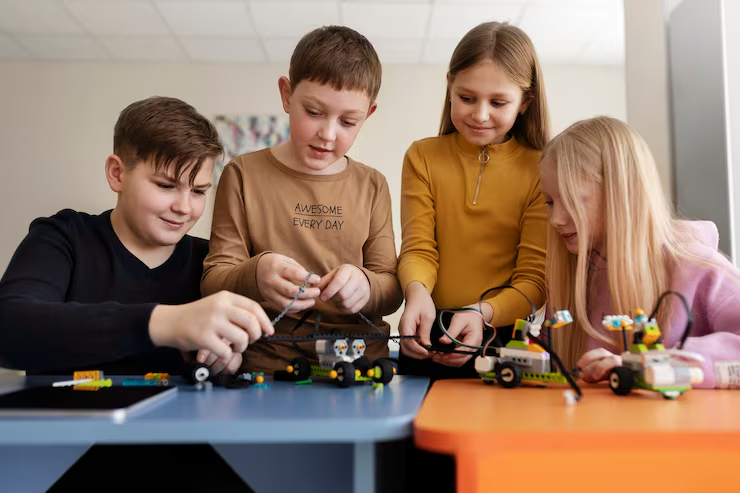At Roboticsera.in, we design robotic toys and work with educators who want to make learning interactive. To support teachers who wish to bring robotics and STEM into their classrooms, we have prepared this Robotics Summer Camp Guide. It is free to use, and any educator can run a summer camp based on it. The guide covers resources, curriculum structure, schedules, and troubleshooting tips to help you plan with confidence.
Getting Started with Resources
The heart of this camp is the Roboticsera Elements DIY Robotics Starter Kit. Each kit includes eight robotic elements, 17 accessories, two sensors, three outputs, two processors, and a rechargeable power bank. A single kit can support multiple projects, and with four kits you can easily handle a batch of six students. We recommend that educators keep an extra kit aside for demonstrations and backup, so there is no interruption in learning.

Along with the kits, you’ll need basic craft supplies. Some items such as straws, sticks, templates, and tape are already included, but you should also stock additional materials like cardboard, craft paper, scissors, glue, thermocol, and coloring tools. These allow children to add structure and creativity to their projects.
The Curriculum Framework
The camp curriculum is designed to progress step by step, starting with basic concepts and moving toward independent projects. Printed manuals and video tutorials are already available with the kits, and our team is always ready to provide teacher training and additional resources whenever needed.
The camp is structured into four stages:
- Introduction to Robotics – An hour-long session where children are introduced to the basics of robotics, including electronics, mechanics, and logic. This is where they begin to understand what robots are and how they function.
- Introduction to Roboticsera Elements – Another hour where kids get hands-on with the elements and accessories, learning how each part works through simple experiments.
- Guided Challenges – A series of structured activities where students follow instructions to build specific projects.
- Open Challenges – Creative sessions where children design their own projects and bring their ideas to life.
Guided Challenges at Three Levels
Beginner Level
At this stage, children spend about 11 hours exploring simple builds like a DIY torch, a basic car with forward and reverse motion, Newton’s disc, and a simple pump. They are encouraged to write down new ideas, attempt small open-ended tasks, and play with their creations to understand how robots respond to their inputs.
Intermediate Level
Intermediate sessions take about 12 hours. Here, children work on more functional projects such as a touchless sanitizer dispenser, an automatic water tap, a smart basketball hoop, or a scribbling robot. They also use worksheets to connect what they’ve learned about sensors with real-life use cases. Teachers challenge them to come up with unique builds, and playtime helps them test their creations in action.
Advanced Level
The advanced stage runs for roughly 18 hours. Students take on ambitious builds like line follower robots, obstacle-avoiding cars, conveyor belts, or even a moving solar system model. They explore how robotics can solve real-world challenges, such as accident prevention systems for sharp turns. Here, open-ended activities and teacher challenges push them to apply creativity, problem-solving, and teamwork.
Open Challenges
Open challenges are the highlight of the camp. At each level, children get dedicated time—ranging from one hour for beginners to four hours for advanced learners—to design projects of their own. They can work individually or in teams, and teachers can later evaluate these projects and even award certificates to recognize their creativity.
Ideal Batch Size and Timings
The recommended batch size is six children with one facilitator. This ensures that each child gets enough attention. Students can begin at the beginner level and progress to advanced sessions as their skills grow. By the end of the camp, they not only learn robotics but also experience teamwork, experimentation, and problem-solving.
Practical Tips for Educators
Teachers are encouraged to customize the schedule using resources like blogs and videos. The model can also extend beyond summer camps and evolve into a full-fledged year-round robotics program. Extra accessories are available whenever needed, and full support is provided for teachers throughout. Facilitators also have the freedom to define their own fee structure based on their setup.
Final Word
The Robotics Summer Camp is more than a series of projects—it’s a platform to inspire curiosity and creativity in children. By combining robotics with hands-on activities, kids not only understand technology but also learn how to think, create, and collaborate.
If you’re ready to start, gather your resources and launch your camp. And remember, the team at Roboticsera.in is always here to guide and support you whenever you need it.
